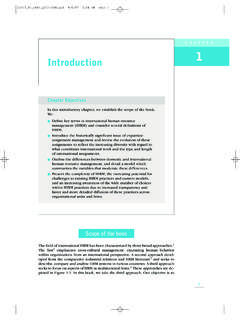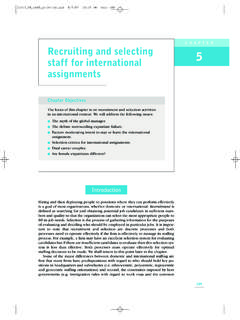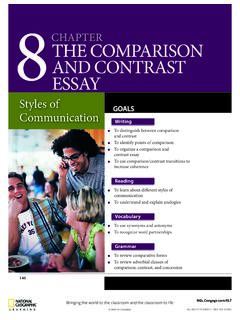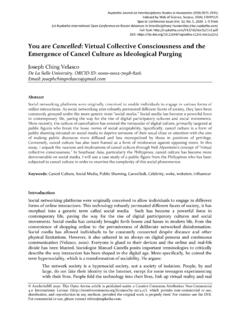Transcription of A student's guide to analysing case studies 2
1 1A student s guide to analysing case studies The purpose of this guide is to help you to maximise your learning when using case studies . It outlines some key issues in using case studies for improving learning. After reading this guide you should be able to: Understand what a case study is Appreciate the benefits of using case studies in the learning of strategic management and how their use can help develop key managerial skills Understand the key steps in analysing case studies Apply theoretical concepts and frameworks to the material in the case Identify and appreciate different ways to present case analysis 1.
2 What is a case study ? A case study is a particular account of a set of circumstances faced by an industry, specific organisation or individual. It provides information about a real life business situation and gives examples of how strategic issues are managed by real organisations. A case study describes an actual situation, such as the current state of an industry and factors influencing it or, for example, specific problems facing an organisation. Typical case scenarios in strategic management might include, for example: an analysis of the external environment in which an organisation is competing; the resources of the organisation; and its core competences.
3 In such a scenario you could be asked to undertake a strategic analysis and identify the key issues facing the organisation, now and in the future. Other scenarios might outline the strategic direction the organisation is pursuing, where the task is to evaluate those strategies. Alternatively, it might asses how an organisation has implemented their strategy or the problems it has encountered in doing so. Whatever the question(s), it will relate to a specific part(s) of the strategic management process. When undertaking such analysis, you would be expected to utilise relevant theoretical concepts and frameworks.
4 2. The benefits of using case studies when studying strategic management In learning about strategic management it is likely that you will engage in lectures and tutorials on a weekly basis. The lecture material presented will identify the key theoretical concepts and tools of strategy as well as some of the key issues facing business managers in today s competitive environment. Whilst the lecture programme might identify some of the key skills required in management practice today, they will not give you the opportunity to actually develop some of those skills yourself. To learn a new skill, you need to practice it.
5 The case study allows you to engage in the practice of strategic 2management by putting yourself in a decision maker s position and forcing you to grapple with real life business scenarios facing actual managers in the workplace. At the same time, it allows you to test your understanding and application of theoretical concepts and frameworks. The table below illustrates some of the key skills you, the student, might develop in using case studies . Table 1: Key skill development in using case studies Analytical skills case studies will usually contain both qualitative and quantitative data. You are forced to think through this material, draw conclusions and justify why you have reached those conclusions.
6 Decision making skills When drawing conclusions, it is likely that you will make decisions or identify a specific course of action for an organisation. In doing this you will first have had to consider alternative courses of action, evaluate those alternatives and select the most appropriate. You will also need to justify why that course of action is the most appropriate. Application You will have the opportunity to demonstrate your understanding of theoretical concepts and frameworks through their application to the given facts and figures in the case . It is likely that you would be awarded marks for such understanding in an assessed piece of work.
7 Communication skills It is likely that you will be required to present your findings to the rest of the group or tutor verbally, as will the rest of your colleagues. In doing that you must be prepared for others to challenge what you present. Remember, there is unlikely to be a definitive answer to set questions in strategic management; there might be several alternative solutions. However, what you will have to do is to justify your decisions, course of action etc. from the analysis you have undertaken. 3 Usually you will work in groups in analysing cases. This enhances your social skills through discussion, debate and compromise.
8 These are important skills in the world of work, where many people work on projects or set tasks as part of a team. You might also be expected to use case analysis as part of an assessment. You must therefore be able to summarise information succinctly and identify the most important points in the case , rather then merely regurgitating word the case word-for-word. 3. Key steps in analysing cases Read the case prior to class discussion! You will learn very little from others presentations or discussion if you have not familiarised yourself with the material and issues involved in the case . Read the case initially to familiarise yourself with its basic content and issues under discussion.
9 What is the case all about? What are the strategic issues highlighted? It might then be a good idea to examine the questions set by your tutor and reread the case thoroughly with these questions in mind. Maybe using a highlighter pen as you reread in light of the task. In doing this, you should hopefully be able to identify how the tools and frameworks of strategic management could be used to answer the questions set. It might be useful to read any set questions prior to you rereading the case , as these can often give you a feel for the type of strategic issues the case may be addressing. Often, there will be tables and charts exhibited in the case .
10 These will be telling a story. You need to study these carefully to identify the story being told. If such exhibits contain data and financial information then this may require you to undertake some analysis of those numbers to examine, for example, growth in an industry, or employ, for example, financial ratios to assess the company s performance. Analysis of such information will help you to justify decisions you make about particular issues or recommendations and could help in validating what you are presenting. You might feel you have inadequate information in a particular case . This is real life.
















